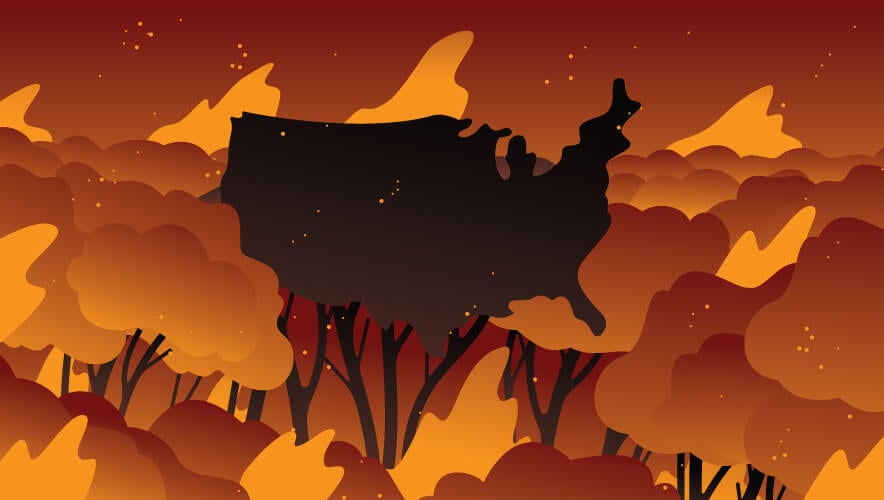Climate Change Responsible for $150 Billion in Damage in the U.S. Every Year
The U.S. government announced the publication of the latest National Climate Assessment on 14 November. The report is the product of several scientists from U.S. agencies, industries, and universities, and it lays out the current and future risks that climate change is expected to have on the nation.
The Fifth National Climate Assessment, which is meant to be published every four years due to a congressional mandate, summarizes the most recent findings in climate science and evaluates how climate change is impacting the nation—including the economy, residents’ public health and safety, and the environment.
Overall, “climate changes are making it harder to maintain safe homes and healthy families; reliable public services; a sustainable economy; thriving ecosystems, cultures, and traditions; and strong communities. Many of the extreme events and harmful impacts that people are already experiencing will worsen as warming increases and new risks emerge,” the report said. And not all communities will be impacted equally.
Global warming is directly responsible for an estimated $150 billion in damage throughout the United States each year, according to the report—but that’s a conservative estimate that doesn’t include lives lost, healthcare costs, or harm to ecosystem services.
More frequent and intense heavy rainfall, storms, and resulting flooding events are already present, notably in the northeast and midwest regions of the United States. The report also noted that urban and agricultural environments are highly vulnerable to flooding, and runoff from heavy rains can pollute drinking water supplies as well as damage homes and buildings.
On the opposite end of the precipitation spectrum, droughts and heatwaves resulted in $328 billion in damage between 1980 and 2022, with recent drought events impacting the agriculture and hydropower industries.
On a national scale, extreme weather and rising sea levels pose a risk to vital infrastructure and transportation that support people, businesses, and services—especially, according to the report, as many infrastructure systems are nearing the end of their useful life. “For example, extreme heat causes railways to buckle, severe storms, overload drainage systems, and wildfires result in roadway obstruction and debris flows. Risks to energy, water, healthcare, transportation, telecommunications, and waste management systems will continue to rise with further climate change, with many infrastructure systems at risk of failing,” the report said.
These impacts are expected to have a domino effect. With communities increasingly dealing with exposure to polluted waters from flooding events and air pollution, the healthcare industry can expect increased demand for medical services. More or longer heatwaves and droughts mean that water and power providers are similarly likely to see greater demand from customers while potentially dealing with damage or disruption from climate change.
The report also found that extreme weather events and other climate-related exposures can increase the risk of emerging infectious diseases, pointing to recent examples where weather events resulted in increased COVID-19 cases. “Crowded housing and reduced hygiene increased disease spread during disaster-related evacuations. COVID-19 also reduced willingness to evacuate to shelters,” the report said.
Anticipated climate change impacts and weather events are also evident in the U.S. economy, with variances dependent upon local climate and the industry. From heatwaves posing health risks to outdoor workers to rising sea temperatures forcing fish (and fisheries) to migrate to decreased crop yields resulting from various stressors—climate change is expected to result in reduced U.S. economic output.
Employment availability is also expected to shift in response to climate events, as businesses like mitigation services, renewable energy, low-carbon technologies, and biofuels are expected to grow—largely in response to efforts to become more climate-friendly or climate-resilient.
In fact, commercial marine fisheries have already felt the brunt of these impacts. “Over the next century, climate change is expected to reduce fish and shellfish catch in all U.S. regions, including some of the highest-valued fisheries,” according to the National Oceanic and Atmospheric Administration (NOAA).
But beyond impacts on businesses, extreme weather disasters are also expected to make life more expensive for everyone, driving up the prices on food, housing, and labor, NPR noted.
The report and its findings are expected to have their own impact. The report “is extremely influential in legal and policy circles, and affects everything from court cases about who should foot the bill for wildfire damage, to local decisions about how tall to build coastal flood barriers,” NPR reported.
For those interested in looking at the latest data and projections regarding local temperatures and precipitation, the report also offers an interactive online atlas. “The atlas is designed to be used by national, state, tribal and community leaders, adaptation planners, researches, educators, and the general public,” NOAA said.











